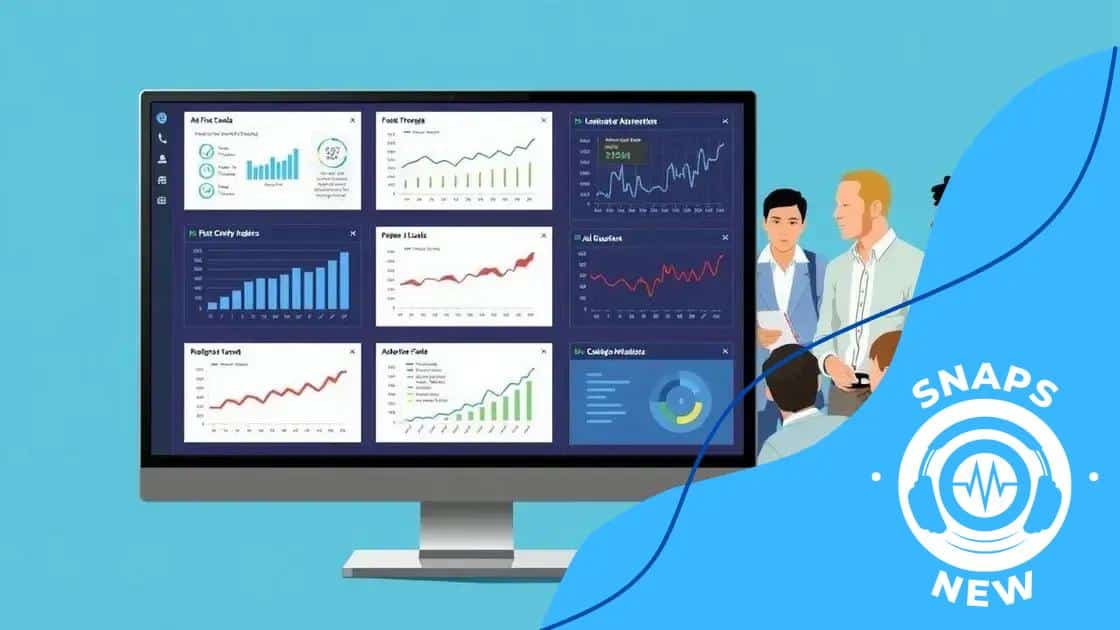AI combating online misinformation: solutions and strategies

AI combating online misinformation involves advanced algorithms and collaborative efforts that enhance information verification, empowering users to discern fact from fiction effectively.
AI combating online misinformation is a pressing issue in today’s digital world. Have you ever wondered how technology can help us discern fact from fiction online? Join me as we delve into this critical topic and explore effective strategies.
Understanding online misinformation
Understanding online misinformation is essential in our digital world. Each day, vast amounts of information circulate online, making it crucial to know what is true and what is false. By grasping the nature of misinformation, we can better navigate the complexities of today’s information landscape.
What is online misinformation?
Online misinformation refers to false or misleading information shared through digital platforms. This can take many forms, such as fake news articles, manipulated images, and misleading social media posts. Understanding what constitutes misinformation helps us recognize its impact on society.
How does misinformation spread?
Misinformation can spread quickly, often going viral within minutes. Here are some key factors that contribute to its rapid spread:
- Social Media Platforms: Users share content, allowing misinformation to reach a broad audience.
- Anonymity: Some people feel empowered to share false information because they can do so without revealing their identity.
- Confirmation Bias: People are more likely to share information that aligns with their beliefs, even if it’s false.
- Emotional Responses: Content that provokes strong emotions is more likely to be shared.
By understanding these factors, individuals can become more critical consumers of information. Recognizing the signs of misinformation can empower everyone to be more responsible online.
Consequences of online misinformation
The impact of misinformation can be severe. It can lead to confusion, distrust, and even harm in some cases. For instance, during a public health crisis, misinformation can hinder measures aimed at protecting the community. Understanding these consequences helps us appreciate the importance of sharing accurate information.
As we become more aware of online misinformation, we can take proactive steps to combat it. Teaching ourselves and others how to verify sources and discern credible information is crucial. This awareness not only benefits us individually but also fosters a more informed society.
The role of AI in combating false information
The role of AI in combating false information is increasingly significant in our digital age. With the vast volume of data online, artificial intelligence can help identify and reduce the spread of misinformation quickly and efficiently.
How AI detects misinformation
AI utilizes various techniques to analyze large datasets and identify potentially misleading information. Through machine learning algorithms, AI systems can learn to recognize patterns that indicate false content. These algorithms are trained on diverse datasets, enabling them to spot anomalies.
Key AI techniques include:
- Natural Language Processing (NLP): This technique allows AI to understand and interpret human language, helping to analyze the text in articles and social media posts.
- Image Recognition: AI can analyze images to detect alterations or identify misleading visuals commonly used in misinformation.
- Data Mining: AI tools sift through vast amounts of data to find sources of misinformation and track its spread across platforms.
- Sentiment Analysis: This helps determine public opinion about certain information, aiding in recognizing content that may lead to spreading false narratives.
Through these techniques, AI not only detects misinformation but also assists in alerting users. Notifications about potentially false content can prompt individuals to verify the information before sharing.
Collaborations between AI and fact-checkers
Another critical aspect is the collaboration between AI systems and human fact-checkers. While AI is efficient in detecting false content, human oversight remains essential to ensure accuracy. Fact-checkers review flagged content, providing an extra layer of scrutiny that enhances reliability.
This partnership between humans and AI enhances trust in online information. By working together, they help foster a more truthful and informed online community. AI continues to evolve, improving its capacity to combat misinformation, making the online environment safer for all users.
Examples of AI tools addressing misinformation

Examples of AI tools addressing misinformation showcase the innovative ways technology helps counteract false information online. With several platforms leveraging AI, individuals can access resources that promote accuracy and reliability in the news.
Fact-checking tools
AI-powered fact-checking tools are instrumental in verifying claims made across various media. They analyze articles and social media posts to determine their accuracy. Some popular tools include:
- Snopes: This site investigates rumors and provides evidence-based conclusions about their truthfulness.
- FactCheck.org: A nonpartisan website that monitors the factual accuracy of statements made by politicians, media, and opinion leaders.
- PolitiFact: Uses a rating system to evaluate statements on a scale from true to false, making facts more accessible to users.
- ClaimBuster: An AI tool that identifies factual claims in a text and links them to reliable sources for verification.
These tools not only help in evaluating the credibility of information but also empower users to disengage from the spread of misinformation.
Social media platforms
Social media companies have implemented AI systems to identify and label misleading content directly. For example, Facebook uses AI to detect potential misinformation before it goes viral. When false content is identified, the platform may:
- Add warning labels: Alerts users that the content may contain false information.
- Limit sharing: Reduces the visibility of misleading posts to prevent further spread.
- Provide fact-check links: Connect users to credible sources for more information.
TikTok has also introduced similar measures, employing AI to flag and remove content that could mislead users. These actions illustrate the commitment of social platforms to improve the quality of information shared.
News aggregators
AI-driven news aggregators help users find reliable news sources quickly. These platforms analyze content from various outlets, emphasizing those with a proven track record of accuracy. For instance, tools like Google News and Apple News use algorithms to curate trustworthy articles while filtering out dubious sources. By doing so, these tools empower users to make informed decisions when consuming news.
Challenges faced by AI in this context
Challenges faced by AI in combating misinformation are significant and multifaceted. Despite the advancements in technology, AI systems encounter various obstacles that can hinder their effectiveness. Understanding these challenges is crucial to enhancing how AI addresses false information.
Data quality
The effectiveness of AI heavily relies on the quality of the data it processes. If the training data contains inaccuracies or biases, the AI can produce misleading results. For example, AI trained on biased datasets may not accurately identify misinformation from diverse sources. To ensure reliability, it’s essential to use high-quality, diverse datasets.
Rapidly changing landscape
The online environment evolves quickly. New platforms emerge, and misinformation tactics change rapidly. AI systems must continuously adapt to these shifts to remain relevant. Here are some factors influencing this challenge:
- Evolving misinformation tactics: Misinformation can take many forms, including deepfakes and altered images. AI must stay updated to recognize new methods of deception.
- Language variations: Different languages and dialects can complicate AI’s ability to detect misinformation accurately.
- Platform diversity: Different social media platforms have various content formats, which can challenge AI’s detection capabilities.
These dynamic factors necessitate ongoing training and adjustments to AI algorithms.
Human oversight
Human input is crucial when it comes to verifying AI findings. While AI can flag potential misinformation, it often requires human fact-checkers to confirm its accuracy. This partnership can be a challenge due to:
- Resource constraints: Many organizations may lack enough trained personnel to review flagged content effectively.
- Speed vs. accuracy: There is often a tension between the need for quick responses and the need for thorough verification, which can slow down the process of combating misinformation.
Understanding these challenges helps in developing more effective AI solutions. Continued collaboration between AI technologies and human experts enhances the ability to fight misinformation.
Future prospects of AI in information verification
The future prospects of AI in information verification are promising and full of potential. As technology continues to evolve, AI is set to play an even larger role in ensuring the accuracy of the information we consume online.
Enhanced algorithms
Advancements in algorithms will improve AI’s ability to detect misinformation. With machine learning, AI systems will become smarter over time, constantly learning from new data. This means AI can identify more subtle forms of misinformation that earlier systems might miss. Here are some critical improvements we might expect:
- Improved accuracy: More precise algorithms will lead to fewer false positives, ensuring that only truly misleading content is flagged.
- Real-time analysis: AI could analyze information as it is published, providing instant verification and alerts.
- Better contextual understanding: Future AI may grasp the context of information better, helping it determine when content is misleading.
As these enhancements take shape, AI will bolster its reputation as a trustworthy resource in combating misinformation.
Integration with user education
Another exciting prospect is the collaboration between AI tools and user education. AI could provide personalized tips and resources to help users discern reliable information. For instance, AI might analyze a user’s browsing habits and suggest educational content on how to identify misinformation effectively. This combination of technology and education will empower users to become critical thinkers.
Cross-platform collaboration
AI’s role in information verification will also benefit from increased collaboration between various platforms. Social media sites, news outlets, and educational institutions can work together to create a unified front against misinformation. By sharing data and insights, AI can learn more about misinformation trends across different platforms. This collaborative effort will enhance the efficacy of AI in combating false information.
As the landscape of misinformation continues to evolve, AI stands ready to adapt and innovate. By harnessing advanced algorithms, focusing on user education, and fostering cross-platform collaboration, the future of AI in information verification looks bright.
\n
FAQ – Frequently Asked Questions about AI and Misinformation
What role does AI play in combating misinformation?
AI helps detect and flag false information quickly by analyzing large amounts of data and identifying patterns associated with misinformation.
How can AI improve its accuracy in identifying false information?
Through continuous learning and enhanced algorithms, AI systems can become more precise in recognizing misleading content and adapting to new misinformation tactics.
Why is user education important in the fight against misinformation?
Educating users on how to verify information empowers them to critically assess what they read and share online, reducing the impact of misinformation.
How can different platforms collaborate to fight misinformation?
Collaboration between social media platforms, news organizations, and fact-checking entities can help share data and insights, improving the overall effectiveness against misinformation.





